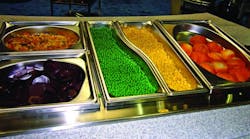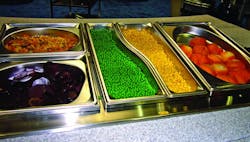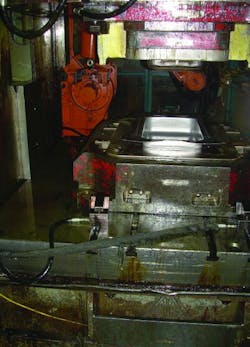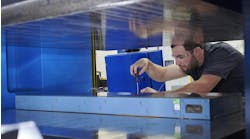Sensor sets the table in simplicity
Whenever you’ve eaten at a restaurant, cafeteria, or anywhere else outside the home, you were most likely served by products from The Vollrath Co. LLC (vollrath.com), Sheboygan, Wis. Vollrath makes a huge variety of both simple and sophisticated products and equipment related to food and beverages — from ketchup squirt bottles to stainless steel cookware and food preparation machines to sophisticated serving stations that keep salads cool and soups hot.
Vollrath uses huge quantities of stainless steel for the products it manufactures. It also makes extensive use of hydraulics to press, bend, and form the material into the required shape for the finished components and products.
Short cycles required
One of the products Vollrath cranks out in high volume is trays for steam tables and salad bars, which are typically found in cafeterias, self serve stations, and restaurants. Trays within a family share a common footprint. For example, all trays may measure about 12-in. wide by 20-in. long but have different depths depending on their capacity. A 12- by 20-in. tray may come in depths of 2, 4, 6, or 8 in.
The trays are typically made from stainless steel sheet that is cut to size, annealed, then transferred to a hydraulic press. Depending on the trays’ dimensions and other application parameters, they may go through multiple pressing and annealing operations.
The press has an upper die powered by hydraulics for motion and pressing force. A single die can be used for most or all trays within a family — the only difference being their depth. The lower die’s cavity is matched to the length and width of the upper die, and its depression can accommodate the deepest pan. For shallower pans, the bottom of the cavity is positioned upward. Once the tray has been pressed, a pneumatic cylinder in the bottom-center of the die rapidly extends to eject the newly formed tray out the the lower die. The machine operator then places the tray on a conveyor for the next production operation.
Vollrath formerly had to set the depth of the lower die using shims and spacers. The time for setup ate into production time, so Werner Kraenzler, manufacturing engineer at Vollrath, looked for a way to automate positioning of the bottom of the die. Integrating a control with the eject cylinder would offer a simple and compact solution, but conventional methods posed serious limitations.
Kraenzler wanted a position sensor that could be adjusted remotely. Reed and proximity switches could not easily be repositioned, and linear pots would not stand up to the repeated shock of the hydraulic press. Plus, stray EMI and RFI noise could interfere with many other types of sensors.
Arriving at a solution
Kraenzler found a solution with the iNSiGHT air cylinder from Motion Controls LLC, Hartford, Wis. Brad Engstrad, president of Motion Controls explained that iNSiGHT is a pneumatic cylinder of standard dimensions incorporating QVLA technology for internally sensing position of the cylinder’s piston. The patented QVLA technique uses light from an LED to illuminate the volume inside the cap end of the cylinder. As the piston moves closer to or away from the cap end, the intensity of the reflected light changes accordingly. A light-detecting diode senses the change in reflected light, which correlates to the piston position. Circuitry within the QVLA generates an electrical signal representative of piston position, and without having to use magnets or gun-drilled piston rods.
Kraenzler says that instead of having to set the depth of the die manually, operators can now extend or retract the cylinder’s piston rod until a digital readout shows the target position. After the position is locked in, the operator can resume production of trays with the press set to the new depth. The quick-change act not only increases productivity, but also makes the press more versatile by allowing a variety of sizes to be run on a single machine.
For more information on iNSiGHT cylinders and QVLA technology, call Motion Controls LLC at (262) 673-9255, or visit motioncontrolsllc.com.



